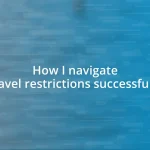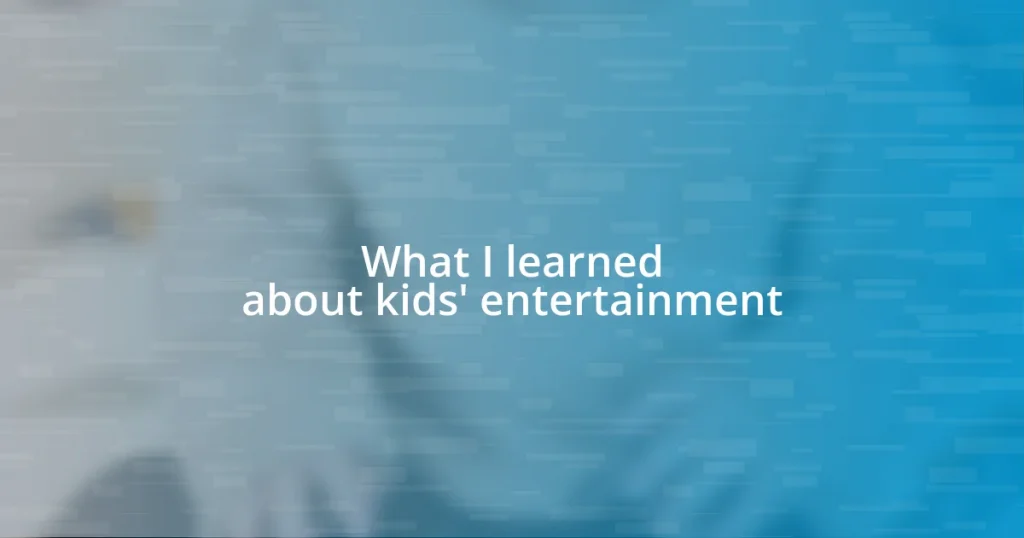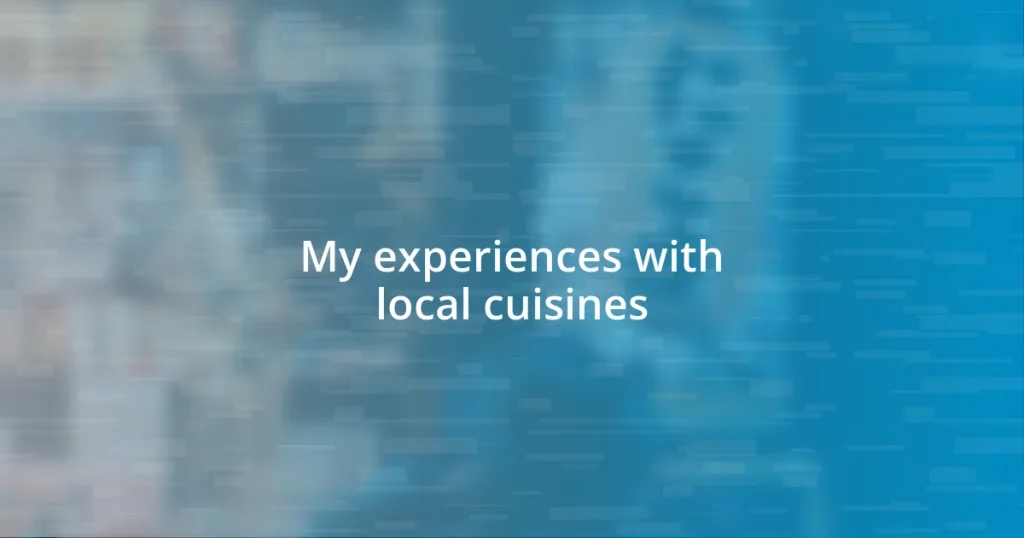Key takeaways:
- Children thrive on age-appropriate content that aligns with their developmental stage, enhancing engagement, social skills, and critical thinking.
- Interactive activities and hands-on experiences foster deep learning and creativity, making entertainment a vehicle for exploration and growth.
- Involving parents in entertainment choices encourages meaningful discussions, helping kids understand content in a reflective and responsible manner.
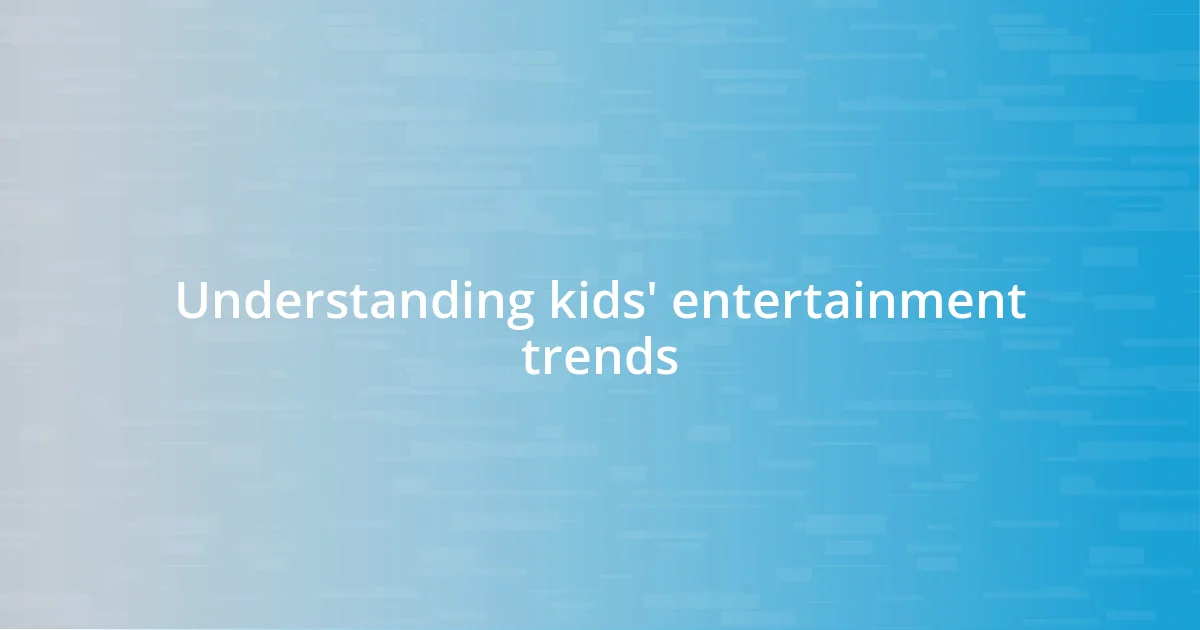
Understanding kids’ entertainment trends
When I think about kids’ entertainment trends, I can’t help but remember my own childhood favorites—like the joy of Saturday morning cartoons. Today, the landscape has shifted dramatically. Streaming platforms now dominate, offering an overwhelming array of choices that can leave both kids and parents feeling a bit lost. How do we guide them through such an abundance?
The shift towards interactive content is fascinating. I recall the first time my niece engaged with an educational game that blended learning with play; her excitement was contagious. These experiences showcase how kids gravitate towards entertainment that not only captivates them but also fosters their development. Isn’t it remarkable how they seek out tools that encourage exploration and creativity?
Moreover, the emphasis on diversity and representation in children’s programming stands out to me. I recently watched a show that celebrated different cultures through its characters and stories. It felt like a pivotal moment because it invites every child to see themselves reflected in the content they consume. How powerful is that for a child’s sense of belonging and identity?

Importance of age-appropriate content
The impact of age-appropriate content is crucial for a child’s development. I remember when my nephew was fixated on a well-produced animated series that was meant for older kids. I noticed how some themes went over his head, leading to confusion rather than enjoyment. It hit me then how significant it is for kids to engage with stories and characters that match their developmental stage—content that sparks joy, understanding, and growth.
In my experience, age-appropriate shows connect with kids more deeply. I’ve seen my daughter light up while watching programs that delve into themes she can relate to, like friendship and problem-solving. When entertainment aligns with their understanding, it not only keeps them engaged but also helps them learn essential social skills. It’s fascinating how narratives designed for their age can encourage empathy and critical thinking; I often find myself discussing the episodes with her long after they’ve ended.
Furthermore, it’s interesting to note how inappropriate content can lead to misunderstandings. Once, during a family gathering, kids were chuckling at jokes from a popular show that didn’t sit well with the younger viewers. I could sense the discomfort in my son as he tried to piece together the humor, which only made me more aware of the need for protective measures around what they watch. A vast gap in age appropriateness can lead to confusion, and it’s an eye-opener to see how vital thoughtful content choices are in nurturing a safe and supportive environment for children.
| Content Type | Age Group |
|---|---|
| Educational Shows | 5-7 years |
| Action-Packed Adventures | 8-12 years |
| Complex Themes | 13 and up |
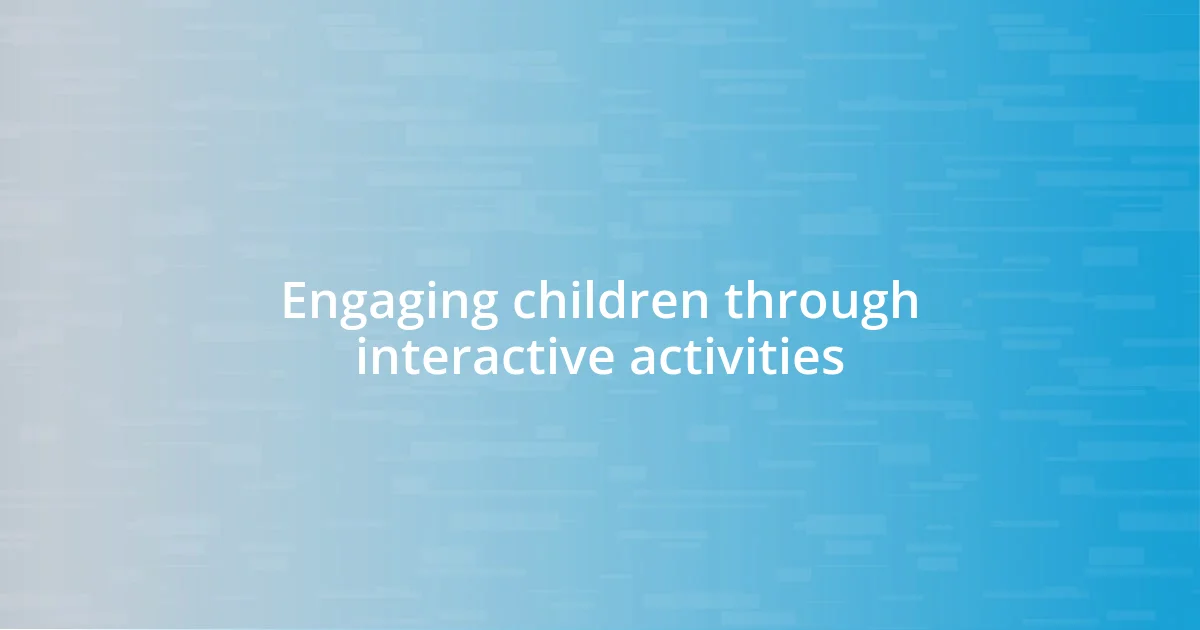
Engaging children through interactive activities
Engaging children through interactive activities has become a cornerstone of their entertainment experience. I’ll never forget the time I took my kids to an interactive science exhibit. They didn’t just observe; they were able to touch, experiment, and even build their own mini-robots. Their eyes sparkled with curiosity, demonstrating that hands-on experiences can ignite a passion for learning in ways passive entertainment simply cannot. It’s these moments where kids feel they have agency in their entertainment choices that pack a real punch.
Here are some engaging interactive activities I’ve seen resonate with kids:
- Hands-On Workshops: Activities where children can create or build something, like art projects or DIY experiments.
- Interactive Games: Apps or educational games that adapt to a child’s skill level, fostering both fun and learning.
- Outdoor Explorations: Nature walks where kids can discover and learn about their environment through guided discovery.
- Role-Playing Activities: Opportunities for kids to act out stories or roles, which enhances their creativity and social interaction.
- Puzzle Challenges: Engaging kids in problem-solving activities that require teamwork, such as escape rooms designed for younger audiences.
I’ve also observed that through interactive storytelling, children can dive into plots where every choice they make affects the outcome. My son once played a narrative-driven game where he had to save characters based on decisions that echoed important life lessons. Afterward, we talked about the moral implications of his choices. It was a beautiful way to see him think critically about actions and consequences, proving that entertainment can marry learning and fun seamlessly.

Balancing screen time and play
Finding the right balance between screen time and play can feel like walking a tightrope sometimes. Recently, I noticed that my kids, after a marathon of their favorite show, struggled to re-engage with their toys. It was a subtle reminder that while screens can offer fantastic stories and learning opportunities, they shouldn’t overshadow physical play, which is essential for their development. How many times have you seen children come to life during unstructured play? That freedom of imagination is where the magic truly happens.
I’ve also experimented with setting limits on screen time. One weekend, I decided to designate “tech-free” hours, where we turned off devices and dove into board games and outdoor activities. The laughter we shared during those game nights was priceless. I could see how much my children thrived when they had the space to invent their own stories and challenges. That day made me realize that active play fosters creativity and social skills in ways that screens simply can’t replicate. It’s invigorating to facilitate those moments where they can explore and navigate their own interaction without the filter of a screen.
Ultimately, I believe a balanced approach means being purposeful with screen time. When my daughter chooses an educational program, I’ll often follow it up with discussions or related hands-on activities to reinforce what she’s learned. This blend creates memorable teachable moments, transforming passive viewing into an interactive experience that’s deeply enriching. Have you tried pairing screen time with follow-up activities? It’s fascinating how it can create a dialogue that connects entertainment with real-world understanding.
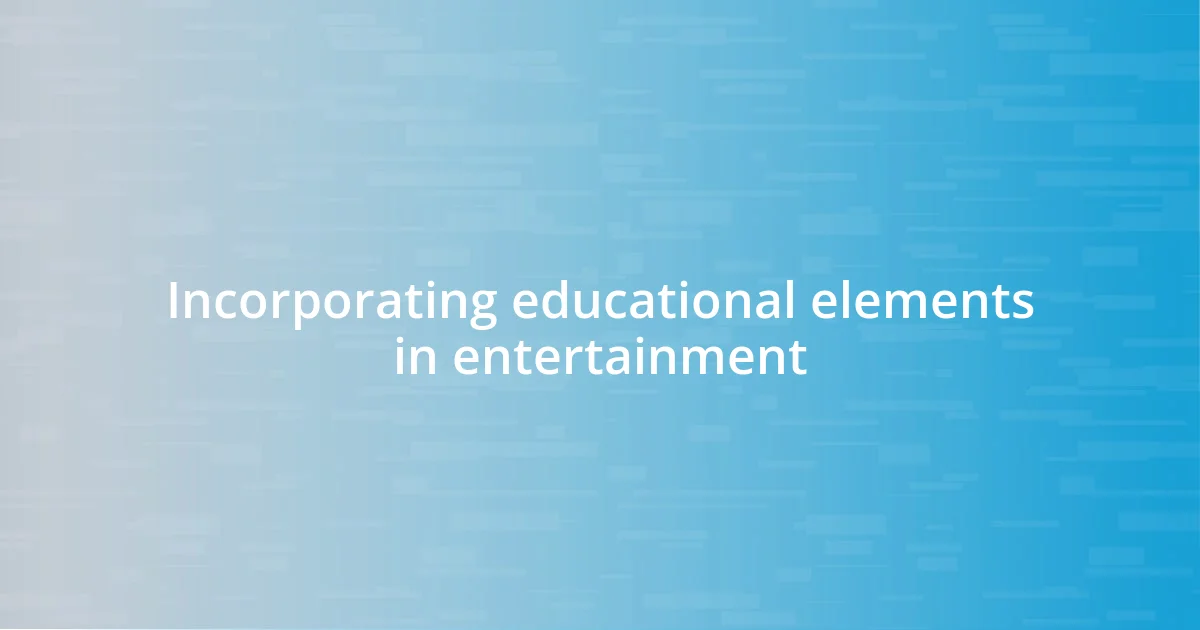
Incorporating educational elements in entertainment
Incorporating educational elements in entertainment is something I’ve come to value greatly. I vividly remember a family movie night where we watched a documentary about ocean life. My kids were captivated by the swirling schools of fish and vibrant coral reefs, but what struck me was their eagerness to learn more afterward. We dove into research together, looking up marine animals and discussing their ecosystems, transforming our cinematic experience into an in-depth learning session. Isn’t it amazing how a good film can open the door to curiosity?
One approach I find truly effective is blending fun with facts, especially through storytelling. I once took part in a community theater workshop with my children, where they not only performed but also learned about historical figures and events through their roles. They gleefully absorbed facts while using their creativity, making learning both exciting and memorable. This interactive form of entertainment really hones in on the idea that education doesn’t have to be rigid; it can be lively and engaging, igniting passion for learning in even the most reluctant students.
Another fantastic method I’ve seen is using games to teach essential skills. I recall a day when my daughter and I played a math-based board game. At first, she thought it would be dull, but by the end, she was counting and strategizing like a pro! It was such a delight to see her grasp mathematical concepts through play. Have you ever taken a step back to realize how much kids can learn when they’re just having fun? This kind of play reinforces the idea that entertainment can serve a dual purpose—providing joy while also enriching young minds.
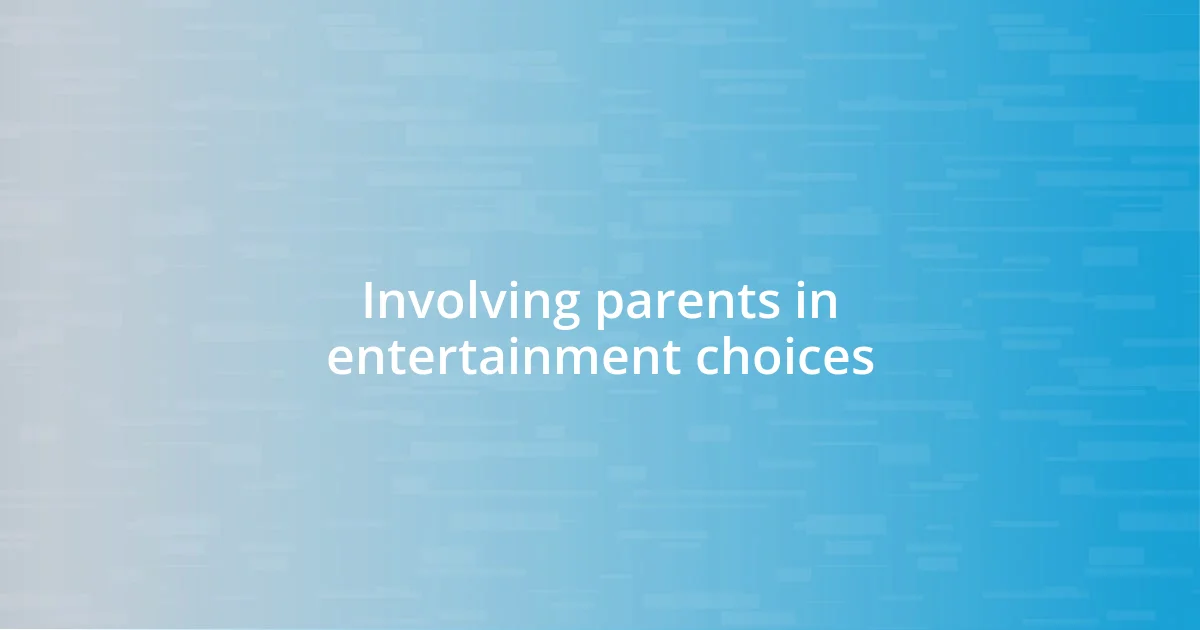
Involving parents in entertainment choices
Involving parents in entertainment choices can truly enhance the experience for children. I remember one afternoon when my son had the opportunity to choose a movie for family night. Instead of simply saying yes or no to his choice, I engaged him in a discussion about what he wanted to watch. We talked about themes, characters, and even the lessons he could learn. That little dialogue transformed the movie night into a collaborative decision-making process, which made him feel valued and more connected to the content.
I’ve found that when we involve parents, it opens up avenues for deeper understanding. For instance, just last week, my daughter expressed an interest in a new animated series. Rather than dismissing it outright, I suggested we watch the first episode together to gauge its appropriateness. As we watched, I paused at moments to ask what she thought about certain scenes or how she felt about the character’s actions. It turned into an enlightening discussion about values and choices, reinforcing the idea that entertainment can be a platform for meaningful conversation.
Engaging parents in entertainment choices is also about setting the right expectations. I often recall a time when my kids wanted to play a video game I deemed a bit too mature for them. Instead of a flat “no,” I encouraged them to research the game—its themes and reviews—empowering them to understand why it might not be suitable. This approach sparked their critical thinking and allowed them to see entertainment not just as a passive activity, but as something that requires reflection. Have you ever considered how a simple conversation can transform a child’s perspective on their entertainment choices?








